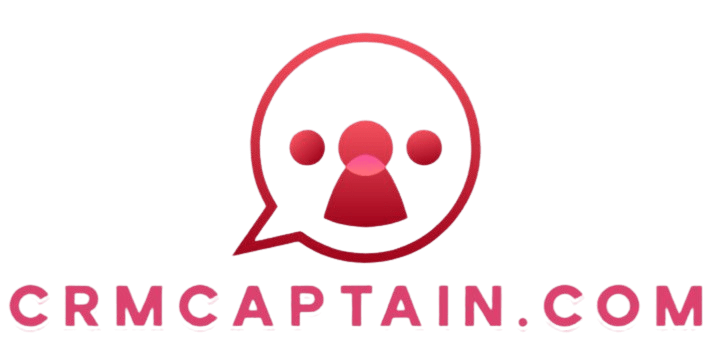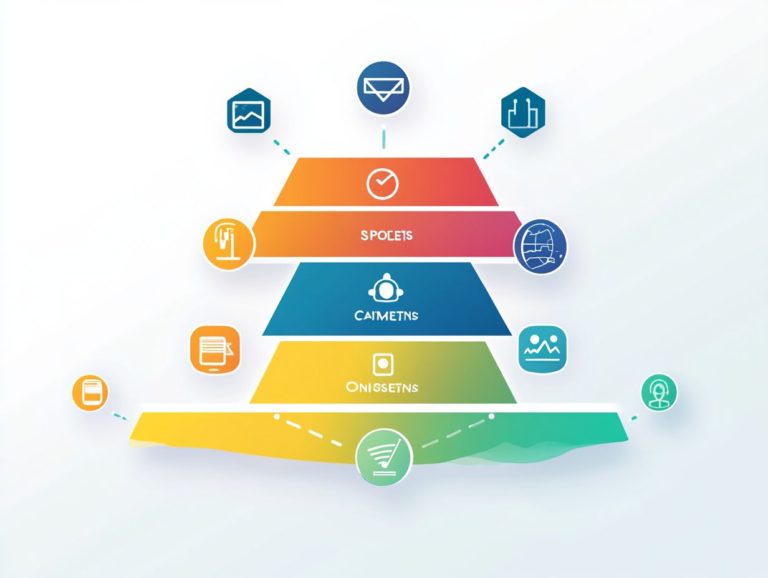Leveraging CRM Analytics: 5 Key Practices
In today’s data-driven landscape, harnessing the power of CRM analytics can truly transform your business.
Prepare to revolutionize how you use data for your business! This article presents five essential practices to effectively leverage CRM analytics: defining your objectives, organizing your data, utilizing visualization tools, and more.
You’ll uncover the myriad benefits of CRM analytics, navigate the common challenges encountered during implementation, and discover how it can significantly enhance your customer retention and acquisition efforts.
Get ready to elevate your approach to data and refine your business strategy.
Contents
- Essential Key Takeaways for Effective CRM Analytics:
- 1. Define Your Objectives and Important Goals
- 2. Clean and Organize Your Data
- 3. Utilize Data Visualization Tools
- 4. Regularly Monitor and Analyze Your Data
- 5. Use Data to Make Informed Business Decisions
- How Can CRM Analytics Benefit Your Business?
- What Are the Common Challenges in Implementing CRM Analytics?
- What Types of Data Can Be Analyzed with CRM Analytics?
- How Can CRM Analytics Help with Customer Retention and Acquisition?
- What Are the Key Components of a Successful CRM Analytics Strategy?
- What Are the Best Practices for Using CRM Analytics to Improve Customer Experience?
- Frequently Asked Questions
- What is CRM Analytics and Why is It Important?
- What Are the 5 Key Practices for Leveraging CRM Analytics?
- How Can Data Collection and Organization Improve CRM Analytics?
- What is the Role of Predictive Modeling in CRM Analytics?
- How Can Businesses Use Data Visualization to Leverage CRM Analytics?
- Why is Customer Segmentation Important in Leveraging CRM Analytics?
Essential Key Takeaways for Effective CRM Analytics:

- Define your objectives and important goals to focus your CRM analytics efforts and measure success.
- Clean and organize your data to ensure accuracy and efficiency in data analysis.
- Utilize tools that help you see your data in charts and graphs to easily interpret and communicate insights from your CRM analytics.
Take action today to unlock the full potential of your CRM analytics!
1. Define Your Objectives and Important Goals
Defining clear objectives is a critical first step in harnessing CRM systems to boost business growth and enhance customer engagement through effective marketing strategies.
By establishing specific and measurable goals, you can meticulously track sales performance, customer satisfaction, and retention tactics.
This ensures that all teams work seamlessly toward shared objectives.
These goals should include immediate financial targets and reflect broader aspirations for customer loyalty and market expansion.
Focusing on conversion rates can unveil the effectiveness of your marketing campaigns, while analyzing retention costs sheds light on your customer relationship management strategies.
By regularly assessing these metrics, you can adapt your marketing strategies to better align with customer needs, cultivating a more engaged and satisfied customer base.
Leveraging these insights allows you to create tailored campaigns that resonate with your audience, ultimately driving sustainable growth and solidifying your position in a competitive landscape.
2. Clean and Organize Your Data
Cleaning and organizing your customer data is crucial for maximizing the effectiveness of your CRM software.
This process enables accurate data analysis, enhances customer profiles, and ensures compliance with data privacy regulations.
Implement methods such as removing duplicates and validating entries to streamline your information.
With clear and precise data at your fingertips, you can gain a deeper understanding of your target audience.
This facilitates refined customer segmentation and allows you to craft tailored marketing strategies that resonate with specific groups.
When consumers feel that their needs are being addressed through personalized interactions, they are far more likely to remain loyal.
This significantly reduces churn rates and fosters long-term relationships that benefit your business.
3. Utilize Data Visualization Tools
Using data visualization tools can greatly enhance your interpretation of CRM analytics.
These tools allow you to easily derive actionable steps from complex data and focus on the performance metrics that fuel revenue growth.
By transforming raw data into visually compelling formats like graphs and dashboards, you can quickly spot trends, understand customer preferences, and identify segments that might benefit from targeted marketing efforts.
For example, platforms like Tableau and Power BI seamlessly connect with various CRM systems, ensuring that real-time data is just a click away.
Visualizing customer interactions allows you to customize your approach, leading to deeper engagement.
As a result, these key insights can inform personalized communication strategies and fine-tuned sales campaigns, ultimately enhancing customer satisfaction and loyalty.
4. Regularly Monitor and Analyze Your Data

Regularly monitoring and analyzing customer interactions is essential for implementing effective sales strategies. Make data-driven decisions that boost conversion rates and enhance customer retention.
Pay attention to these important indicators. You ll uncover valuable insights into consumer behavior and preferences.
This understanding is key to your success! It enables you to tailor your marketing efforts in ways that resonate with your audience.
Utilizing methods like understanding customer feelings and using data to forecast future customer behavior can greatly assist you in deciphering customer data.
By identifying trends and anticipating future needs, you can refine your marketing campaigns, ensuring you deliver the right messages at the right times.
Ultimately, this approach leads to a more satisfying customer experience, fostering loyalty and driving long-term success for your brand.
5. Use Data to Make Informed Business Decisions
Leveraging data-driven insights enables you to make informed decisions. Align your strategies with customer preferences to elevate your sales performance and brand loyalty.
By analyzing customer behavior, market trends, and engagement metrics, you can pinpoint what truly resonates with your audience.
Think of how Netflix recommends shows based on what you watch. That s using data to create a better experience!
For example, a popular e-commerce platform harnesses customer purchase history and browsing habits to craft personalized recommendations. This approach has led to a remarkable surge in conversion rates.
A major beverage company has adopted real-time analytics to refine its advertising campaigns. This allows for targeted promotions that speak directly to consumers’ interests.
These examples show how effectively utilizing data analytics enhances customer interactions and fine-tunes your marketing outreach.
How Can CRM Analytics Benefit Your Business?
CRM analytics can profoundly elevate your business. It delivers insights that catalyze growth and boost customer retention.
By leveraging these analytics, you can refine your customer segmentation. Identify and understand distinct groups effectively.
This enables you to develop tailored solutions that truly resonate with specific needs, enhancing customer satisfaction.
Enhanced sales performance metrics help you evaluate your strategies more precisely, offering a clearer view of which approaches deliver the best results.
Integrating these insights into your decision-making processes enhances operational efficiency and cultivates deeper relationships with your customers.
Deliver exceptional experiences that inspire loyalty and advocacy!
What Are the Common Challenges in Implementing CRM Analytics?
Implementing CRM analytics can come with challenges like data privacy concerns and user adoption hurdles.
These obstacles arise from the disconnect between established practices and the new tools that CRM systems introduce. This can lead to resistance from employees accustomed to legacy methods.
If data security measures aren t communicated clearly, it may create unease about adopting the new software.
Without adequate training, users might not grasp the full potential of CRM analytics, leading to underutilization.
To tackle these challenges, it s essential to prioritize comprehensive training programs and ongoing support. This allows users to feel confident in navigating the system.
By fostering an environment that encourages questions and incorporates feedback into training, businesses can enhance user adoption and the overall success of their CRM initiatives.
What Types of Data Can Be Analyzed with CRM Analytics?

CRM analytics provides you with the ability to delve into a diverse array of data, encompassing customer information, consumer behavior patterns, and interactions across multiple marketing channels. This analysis helps you better understand the customer journey.
By examining demographic details such as age, income, and location, you can discover valuable insights that reveal what different customer groups really want. Analyzing purchase history reveals trends in buying behavior, enabling you to identify which products are favored at various times.
Customer engagement metrics including website visits, email open rates, and social media interactions are equally crucial. These metrics allow you to track customer interests and refine your strategies accordingly.
Together, these insights enable you to enhance customer profiles, resulting in more effective personalized marketing efforts that truly resonate with your target audience.
How Can CRM Analytics Help with Customer Retention and Acquisition?
CRM analytics is essential for elevating your customer retention and acquisition strategies by harnessing predictive insights that help you understand customer needs and enhance their experiences.
By diving into historical data, you can pinpoint high-value leads likely to convert, allowing you to concentrate your efforts on nurturing these promising prospects.
For example, you might find that customers who buy a specific product bundle are more inclined to return if they receive personalized follow-up offers. This insight helps you create targeted campaigns that resonate with leads and build loyalty with personalized communication.
Use data-driven strategies like loyalty programs and personalized discounts to keep customers engaged. This leads to greater lifetime value for your business.
What Are the Key Components of a Successful CRM Analytics Strategy?
A successful CRM analytics strategy includes essential components like clear objectives, strong data handling, user-friendly tools, and continuous monitoring, all designed to elevate customer engagement and propel business growth.
These elements work in harmony to ensure you re not just tracking customer interactions effectively but also extracting actionable insights from the data you gather.
By aligning these components with your overarching business goals, you can customize your marketing strategies, refine sales processes, and enhance customer service initiatives. This comprehensive approach provides you with a deeper understanding of customer preferences and behaviors, significantly boosting satisfaction and loyalty.
Ultimately, a well-defined analytics strategy enables you to make informed decisions, allowing your team to pivot and adapt to shifting market trends, thereby elevating sales performance to unprecedented levels.
What Are the Best Practices for Using CRM Analytics to Improve Customer Experience?
Implementing best practices for CRM efficiency is essential for elevating your customer experience, allowing you to develop effective engagement strategies tailored to the unique needs of each individual customer.
By consistently monitoring customer engagement metrics, you can uncover trends and patterns that reveal which strategies truly resonate with your audience. Additionally, leveraging customer feedback provides invaluable insights into areas that may require adjustment or improvement.
When you prioritize these practices, you cultivate genuine interactions that not only enhance satisfaction but also foster long-term brand loyalty. As your customers feel more understood and valued, they’re likely to forge a deeper connection with your brand, paving the way for enduring relationships and sustained business success.
Frequently Asked Questions

Ready to leverage CRM analytics? Start your journey toward improved customer experiences today!
What is CRM Analytics and Why is It Important?
CRM analytics uses data from customer relationship management systems to provide valuable insights. This process helps businesses understand customer behaviors and preferences, which is key to effective marketing and enhanced customer satisfaction.
What Are the 5 Key Practices for Leveraging CRM Analytics?
The five key practices include data collection, analysis, visualization, predictive modeling, and customer segmentation. Following these practices can help businesses better understand their data and improve customer relationships, especially by maximizing CRM features.
How Can Data Collection and Organization Improve CRM Analytics?
Data collection and organization involve gathering customer data from sources like social media, websites, and purchase history. This comprehensive view allows for accurate analysis and better decision-making.
What is the Role of Predictive Modeling in CRM Analytics?
Predictive modeling analyzes past customer data to forecast future behaviors. This technique helps businesses tailor marketing strategies to meet customer needs effectively.
How Can Businesses Use Data Visualization to Leverage CRM Analytics?
Data visualization tools like charts and dashboards present information in clear formats. This clarity helps decision-makers spot trends and make informed, data-driven choices.
Why is Customer Segmentation Important in Leveraging CRM Analytics?
Customer segmentation divides customers into groups based on shared traits like demographics and behaviors. This approach enables businesses to personalize marketing efforts, improving customer satisfaction and loyalty.






